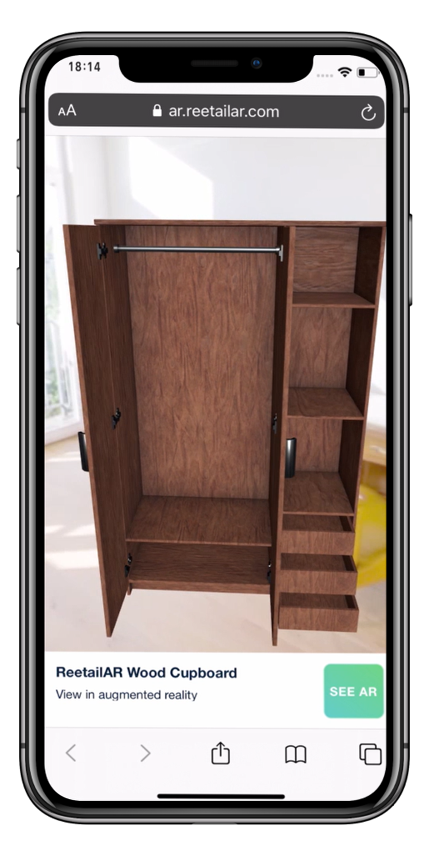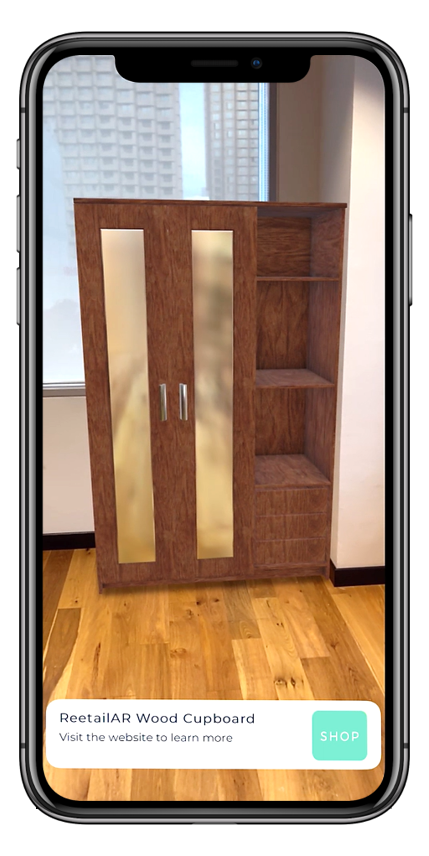Augmented Reality (AR) is a technology that superimposes computer-generated content, such as images, videos, and 3D models, onto the real-world environment. AR enhances the user’s perception of reality by overlaying digital elements onto the physical world, allowing users to simultaneously interact with both real and virtual objects.
Virtual Reality (VR) is a technology that immerses users in a completely artificial, computer-generated environment, typically experienced through a head-mounted display (HMD) or VR headset. There is a very distinct difference between AR and VR. When it comes to AR, we are still within the real world – we are connected to it. When it comes to VR, we find ourselves in a dystopian digital world without any physical connection to the real world. Unfortunately, to date, many articles still confuse VR with AR.
Online vs. Offline Use
The use cases for online usage are manifold. In advertising and marketing, brands can use AR to create interactive and engaging online ads that allow customers to virtually try products before buying them or to experience immersive brand campaigns. In e-commerce, AR can enhance the online shopping experience by enabling customers to visualize products in their real-world environments using 3D models before making a purchase, such as trying on virtual clothes or placing furniture in their living rooms. In gaming, online AR games have gained popularity due to the success of mobile apps such as Pokemon GO, which create interactive and location-based gaming experiences. AR can be used in online education platforms to provide interactive and visual learning experiences, making complex concepts more accessible and engaging. In addition, AR filters, which have been popularized by apps such as Snapchat and Instagram, allow users to add fun and interactive elements to their photos and videos.
In offline settings, AR can be used to provide interactive navigation guidance at shopping centers, museums, airports, and other complex spaces, thereby helping users find their ways more efficiently. When it comes to in-store sales, AR allows salespeople to demonstrate products in 3D, which allows customers to see how such items would look and fit in their homes or workplaces, showcasing product features and benefits in an interactive way. Such visualization can be especially useful for large or complex products, such as furniture, appliances, and machinery. With AR, product recommendations can be tailored to individual customers, depending on their preferences and needs.
AR can also assist in the creation of product manuals. AR can be utilized to overlay instructions or step-by-step guides on physical products, making assembly or repair processes more accessible. In offline events and theme parks, AR can be integrated into attractions and shows to create interactive and immersive experiences for visitors. AR can also enhance traditional art exhibits with interactive elements and storytelling. In addition, AR can offer hands-on training and simulations for various industries, such as healthcare, aviation, and engineering, thereby providing trainees with realistic and safe environments in which to practice. In healthcare, AR can be employed in surgery planning, medical training, and patient education, providing 3D visualizations of anatomy and medical procedures. Automotive companies can also use AR to display real-time information on windshields, such as navigation directions and car performance data.

web-based AR which can be
launched directly from any
smartphone web browser;
no additional app needed. /// credit: Omniaz

projected onto real world
environments in 3D, with
size to scale, so consumers
can visualize the look and fit. /// credit: Omniaz
Customer Feedback from B2B Trading?
At our company, we have seen a growing interest in these solutions. We generally get very good feedback from our customers. In 2023, most retailers/brands have an allocated budget for AR solutions. Nevertheless, the process is still lengthy – you have to work your way up from a smaller project to larger projects and scale. That is because the industry is still in its early stages. In e-commerce, for example, every brand/retailer has now heard of AR and has some touch points. However, if you look at how big the share of immersive/3D applications is on the web, we are still talking about less than 5%. That, of course, depends on the market. There is still a great deal of potential, however, and I firmly believe that in 10 years, all of the products that we buy will be in 3D/AR, because the future will be immersive.
Importance of End Customers
Even though we only offer B2B(2C) solutions – that is to say, we only work with businesses – the end consumer is our main focus. The reasons behind why our customers implement AR-based solutions in online and offline configurations are, of course, closely tied to business metrics/KPIs, which, in turn, are tied to how well the solution is perceived by customers. Based on such metrics, customer feedback is really good as conversion rates have increased by 30% or more online. Other feedback from offline cases has shown really good indications, which is why we would like to further roll out our solutions and extend them to more stores and countries using our existing clients.
What Can We Expect Next? How Are These Technologies Evolving?
When it comes to end customer awareness, we are moving closer and closer toward everyone using AR in one way or another on a daily basis. Virtual tryouts will be a big push in that direction, through the use of apps such as Google Maps or Google Lens, or hardware developments such as Apple Vision Pro. Technology, specifically software and hardware, will continue to get better and better. The next big thing will be affordable/lightweight AR glasses, which will be a major push toward mass adoption.
Impact of New Gadgets
Apple Vision Pro is an example of a gadget that has been long awaited. The impression that people have gotten from the media is that this is the gadget that marks the beginning of mass adoption. However, it is not – at least not the first version. It is too expensive, the battery life is too short, it is too clunky. Nevertheless, it is a starting point and a big push toward mass adoption – a full immersion of our lives that can only be provided by AR, not VR. The industry has been waiting for this release for years, and it has had a very positive impact on the whole AR/VR topic. It seems (to me) that the media is finally starting to better distinguish between the two technologies and their co-existing, but very different, applications and, most importantly, their impact on our future.

Marc Giovannini
Marc Giovannini is COO & Co-Founder at Omniaz – Augmented reality (AR) solution for Retail & Ecommerce.






